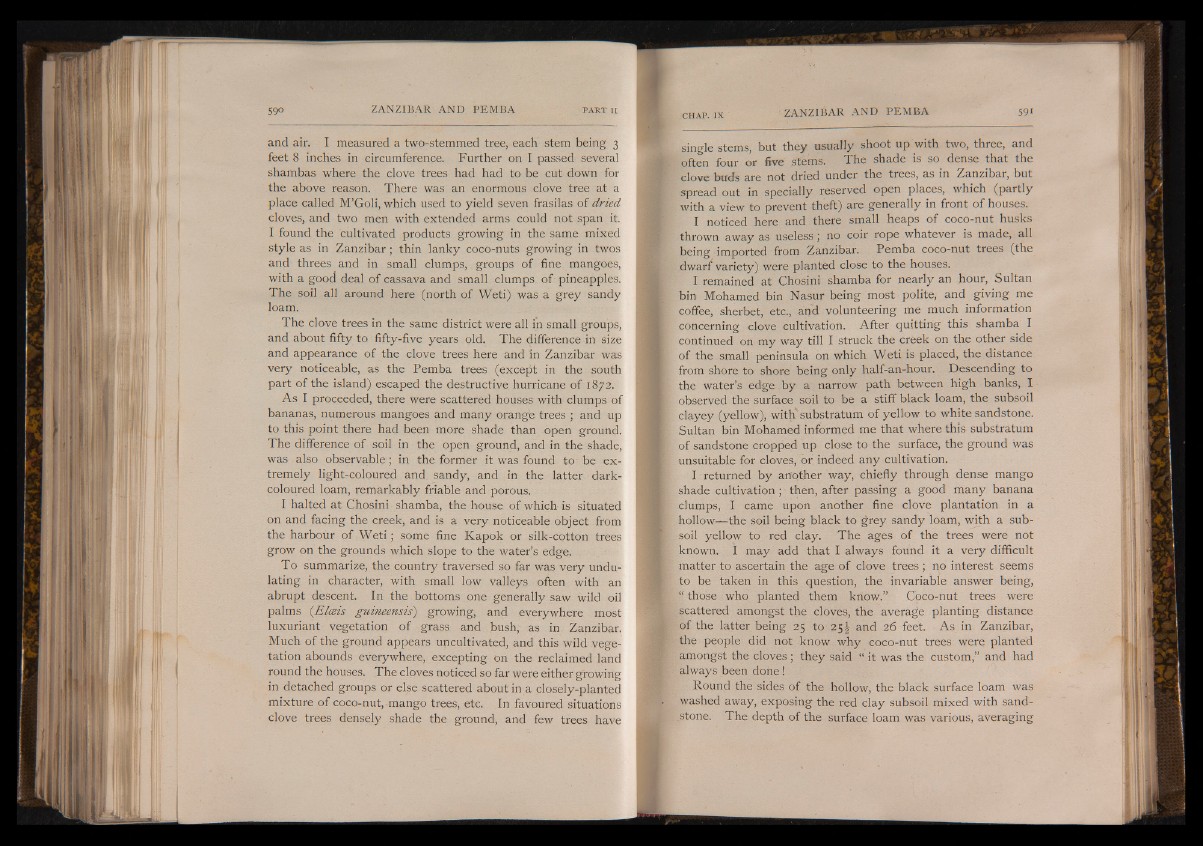
and air. I measured a two-stemmed tree, each stem being 3
feet 8 inches in circumference. Further on I passed several
shambas where the clove trees had had to be cut down for
the above reason. There was an enormous clove tree at a
place called M’Goli, which used to yield seven frasilas of dried
cloves, and two men with extended arms could not span it.
I found the cultivated products growing in the same mixed
style as in Zanzibar; thin lanky coco-nuts growing in twos
and threes and in small clumps, groups of fine mangoes,
with a good deal of cassava and small clumps of pineapples.
The soil all around here (north of Weti) was a grey sandy
loam.
The clove trees in the same district were all in small groups,
and about fifty to fifty-five years old. The difference in size
and appearance of the clove trees here and in Zanzibar was
very noticeable, as the Pemba trees (except in the south
part of the island) escaped the destructive hurricane of 1872.
As I proceeded, there were scattered houses with clumps of
bananas, numerous mangoes and many orange trees ; and up
to this point there had been more shade than open ground.
The difference of soil in the open ground, and in the shade,
was also observable; in the former it was found to be extremely
light-coloured and sandy, and in the latter dark-
coloured loam, remarkably friable and porous.
I halted at Chosini shamba, the house of which is situated
on and facing the creek, and is a very noticeable object from
the harbour of W e ti; some fine Kapok or silk-cotton trees
grow on the grounds which slope to the water’s edge.
To summarize, the country traversed so far was very undulating
in character, with small low valleys often with an
abrupt descent. In the bottoms one generally saw wild oil
palms (Elceis guineensis) growing, and everywhere most
luxuriant vegetation of grass and bush, as in Zanzibar.
Much of the ground appears uncultivated, and this wild vegetation
abounds everywhere, excepting on the reclaimed land
round the houses. The cloves noticed so far were either growing
in detached groups or else scattered about in a closely-planted
mixture of coco-nut, mango trees, etc. In favoured situations
clove trees densely shade the ground, and few trees have
single stems, but they usually shoot up with two, three, and
often four or five stems. The shade is so dense that the
clove buds are not dried under the trees, as in Zanzibar, but
spread out in specially reserved open places, which (partly
with a view to prevent theft) are generally in front of houses.
I noticed here and there small heaps of coco-nut husks
thrown away as useless ; no coir rope whatever is made, all
being imported from Zanzibar. Pemba coco-nut trees (the
dwarf variety) were planted close to the houses.
I remained at Chosini shamba for nearly an hour, Sultan
bin Mohamed bin Nasur being most polite, and giving me i^ | coffee, sherbet, etc., and volunteering me much information
I concerning clove cultivation. After quitting this shamba I
' continued on my way till I struck the creek on the other side
of the small peninsula on which Weti is placed, the distance
I from shore to shore being only half-an-hour. Descending to
the water’s edge by a narrow path between high banks, I
I observed the surface soil to be a stiff black loam, the subsoil
I clayey (yellow), with" substratum of yellow to white sandstone.
' Sultan bin Mohamed informed me that where this substratum
I of sandstone cropped up close to the surface, the ground was
unsuitable for cloves, or indeed any cultivation.
I returned by another way, chiefly through dense mango
I shade cultivation; then, after passing a good many banana
I clumps, I came upon another fine clove plantation in a
hollow®-the soil being black to grey sandy loam, with a sub-
| soil yellow to red clay. The ages of the trees were not
r known. I may add that I always found it a very difficult
matter to ascertain the age of clove trees ; no interest seems
I to be taken in this question, the invariable answer being,
' “ those who planted them know.” Coco-nut trees were
f scattered amongst the cloves, the average planting distance
; of the latter being 25 to 25 J and 26 feet. As in Zanzibar,
- the people did not know why coco-nut trees were planted
; amongst the cloves ; they said I it was the custom,” and had
always been done!
Round the sides of the hollow, the black surface loam was
K washed away, exposing the red clay subsoil mixed with sand-
j stone. The depth of the surface loam was various, averaging